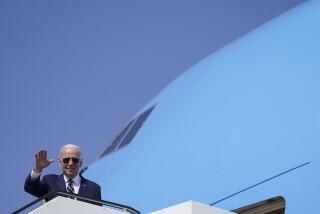A Weaker Dollar Leaves U.S. Shortchanged in Asia
- Share via
Distant trends spelled bad news for U.S. companies and jobs last week, while a couple of overseas events were more hopeful. And if you understand why, you may be able to set the Clinton Administration straight about policy or at least have a clue about how a changing world affects you.
The trade figures for March were bad, a $10.2-billion trade deficit caused particularly by an excess of imports from Asia. Japan shipped $5.3 billion more in merchandise to the United States than it bought from U.S. suppliers; the 1993 trade imbalance with Japan may be even worse than last year’s $50-billion deficit.
China, Hong Kong, South Korea, Taiwan and Singapore also ran a trade surplus with the United States--although no other region of the world did.
It was nothing to take lightly. Large trade deficits put a damper on U.S. production, lower economic growth and prevent job creation.
Yet the Clinton Administration responded only with brain-dead claims that a lower dollar will correct the trade imbalance, eventually, by making foreign goods dearer and U.S. products cheaper. But that won’t happen. A lower dollar has little effect on Japan’s trade practices, for several historic reasons. And it has no effect on places like Hong Kong and Taiwan which peg their currencies to the dollar.
All the policy does is lower U.S. living standards along with the ability of U.S. companies to invest in Asia, which would be one way to earn profits, create U.S. jobs and address the trade problem.
Something more forceful than dollar devaluation will have to be tried--and we’ll see what that is.
But first the good news. The Danes voted Tuesday to support closer economic and political union in Europe, reversing a negative vote last year. And the British House of Commons supported European union by a 2-to-1 vote on Thursday.
The votes mean that Europe, a good customer for American goods in more ways than one, might start recovering from its deep recession. “It may not be a big push, but I think it’s a help toward coming out of the crisis,” says Andreas Van Agt, the European Community’s ambassador to the United States.
That’s encouraging. Western Europe took more than $114 billion worth of U.S. exports last year, 26% of the total--and gave the U.S. a $3 billion trade surplus. But this year U.S. exports have suffered because countries in recession don’t buy goods, no matter how cheap a lower dollar makes them.
Moreover. U.S. companies have substantial investments in Europe--as unfortunately they do not in Asia. Of roughly $475 billion in U.S. investment overseas, almost 50% is in Europe but only 11% is in Asia, including Japan.
Normally that’s a boon. General Motors, Ford, IBM and other U.S. companies usually earn good money in Europe--profits that directly or indirectly help finance investments in the United States. Also, a brisk exchange of goods and services among divisions of multinational companies spurs commerce on both sides of the Atlantic.
So clearly an expanding Europe tomorrow will help us all, but a European recession hurts us all today.
Asia is different. Not only is U.S. business investment relatively low, but a U.S. trade deficit with the emerging economy of China--$18 billion last year--threatens to duplicate the chronic problem of Japan.
One way to find a solution is to separate Japan and the rest of Asia in your thinking, suggests Michael Borrus, an associate of the Berkeley Roundtable on International Economics--the research institute where Laura Tyson worked before becoming chief economic adviser in the Clinton Administration.
The U.S. problem with Japan lies in postwar history and the automobile industry. The U.S. opened its market to Japanese exports after World War II as a means of encouraging development. It was an Asian equivalent of the Marshall Plan that revived Europe.
But Japan--which has been ruled by the same political party all these years--is still living in that postwar trade cocoon. That’s why its automobile industry produces 14 million cars a year for a home market that buys 7 million or fewer. The remainder are exported and constitute the bulk of the United States’ $40-billion trade deficit in automobiles and parts--roughly half the total U.S. trade deficit, petroleum making up the other half.
Lowering the dollar against the yen--making Japanese cars more expensive in the United States--may persuade Japan’s auto makers over time to build more cars in U.S. plants. But a quicker cure, now gaining support in Washington, is simply to tell the Japanese government to cut the trade deficit. Japan can buy other products, ship fewer autos, whatever--the result should benefit U.S. production. What’s needed is a shift from a relationship that has grown parasitic and troubled.
On the other hand, China, South Korea, Taiwan, Hong Kong and Singapore--which last year bought $54 billion in U.S. goods--represent great opportunity. Their economies, growing 7% to 10% a year, should be a prime area for U.S. investment, which could grow businesses as U.S. companies grew with Western Europe in the last 40 years.
A lower dollar does not encourage such investment, which is why policy should change. The aim should be to make Asia what Europe has become, a trade partner not a parasite.
More to Read
Inside the business of entertainment
The Wide Shot brings you news, analysis and insights on everything from streaming wars to production — and what it all means for the future.
You may occasionally receive promotional content from the Los Angeles Times.










